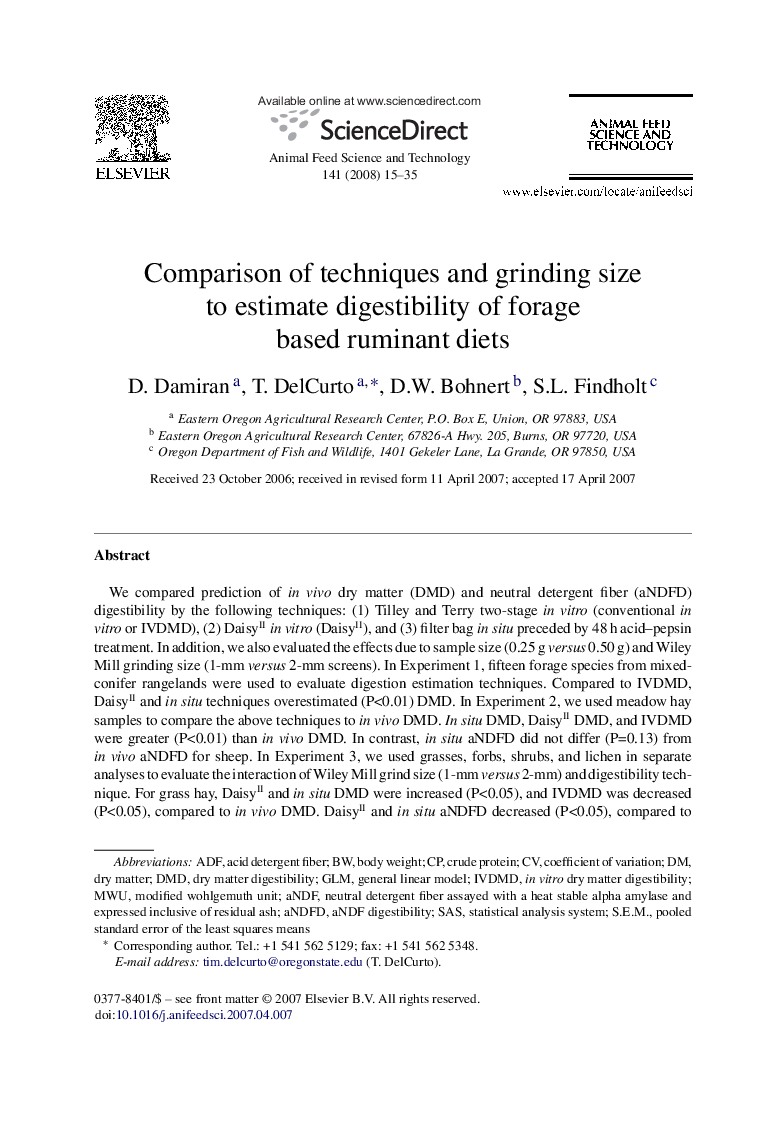| کد مقاله | کد نشریه | سال انتشار | مقاله انگلیسی | نسخه تمام متن |
|---|---|---|---|---|
| 2420675 | 1552474 | 2008 | 21 صفحه PDF | دانلود رایگان |

We compared prediction of in vivo dry matter (DMD) and neutral detergent fiber (aNDFD) digestibility by the following techniques: (1) Tilley and Terry two-stage in vitro (conventional in vitro or IVDMD), (2) DaisyIIin vitro (DaisyII), and (3) filter bag in situ preceded by 48 h acid–pepsin treatment. In addition, we also evaluated the effects due to sample size (0.25 g versus 0.50 g) and Wiley Mill grinding size (1-mm versus 2-mm screens). In Experiment 1, fifteen forage species from mixed-conifer rangelands were used to evaluate digestion estimation techniques. Compared to IVDMD, DaisyII and in situ techniques overestimated (P<0.01) DMD. In Experiment 2, we used meadow hay samples to compare the above techniques to in vivo DMD. In situ DMD, DaisyII DMD, and IVDMD were greater (P<0.01) than in vivo DMD. In contrast, in situ aNDFD did not differ (P=0.13) from in vivo aNDFD for sheep. In Experiment 3, we used grasses, forbs, shrubs, and lichen in separate analyses to evaluate the interaction of Wiley Mill grind size (1-mm versus 2-mm) and digestibility technique. For grass hay, DaisyII and in situ DMD were increased (P<0.05), and IVDMD was decreased (P<0.05), compared to in vivo DMD. DaisyII and in situ aNDFD decreased (P<0.05), compared to in vivo aNDFD. In contrast, straw IVDMD and DaisyII and in situ DM and aNDF digestibility were decreased (P<0.01) compared to in vivo DM and aNDF digestibility. DaisyII and in situ digestibility estimates were greater (P<0.01) for grass hay milled at 1-mm versus 2-mm, while all digestibility estimates were higher (P<0.01) for straw ground at 1-mm. For the DaisyII and in situ techniques, a 0.25 g sample resulted in greater (P<0.05) estimates of digestibility than a 0.5 g sample.Digestibility values estimated by DaisyII and in situ techniques were correlated (r2 = 0.58–0.88) with values estimated by conventional in vitro and in vivo techniques, although in most cases, DaisyII and in situ techniques overestimated DM and aNDF digestibility. The sieving off of different size particles in the ground forage sample, correcting for the fine particle losses from the filter bag during digestion, washing, and/or grouping the feeds into categories based on cell wall structure, and applying a corresponding correction factor may increase predictability and accuracy of DaisyII technique.
Journal: Animal Feed Science and Technology - Volume 141, Issues 1–2, 1 March 2008, Pages 15–35